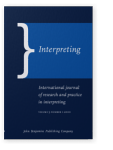Vol. 5:1 (2000) ► pp.25–48
Listening comprehension, shadowing and simultaneous interpretation of two ‘non-standard’ English speeches
Ten final-year interpreting students, all native speakers of Italian, were asked to perform three tasks using two ‘non-standard’ English speeches, one by an Indian speaking English as a second language (speaker A), and one by an American speaking English as a native language with a strong accent (speaker B). The duration of each speech was about 11 minutes, of which a different section was used for each task. First, subjects listened to the initial part of each speech (about 3 minutes) and were tested for listening comprehension. They then shadowed part of the speeches (about 2 minutes), after which they simultaneously interpreted the remainder from English into Italian. The working hypotheses were that: (i) the three tasks involve an increasing level of complexity: listening comprehension being the simplest and simultaneous interpretation the most difficult; (ii) ‘non-standard’ language in the source speech is a potential problem trigger for the interpreter. Performance in the three tasks was evaluated by examining the subjects’ answers to questions in the listening comprehension task (the highest score possible being 12), and by transcribing the shadowing and the simultaneous interpretation (both scored on a 12 point scale). In addition, subjects’ handling of previously identified problem areas in each simultaneous interpreting task was evaluated, again on a 12 point scale. Scores for each task were divided into bands, to distinguish between ‘very high’, ‘high’, ‘low’, and ‘very low’. Performance in the three exercises partly reflected their growing complexity, listening comprehension being the simplest and simultaneous interpretation the most difficult. The non standard characteristics of the two speeches were indeed difficult for some of the subjects to interpret. Taking Gile’s Effort Model as a theoretical basis, the study also provides some insight as to which phase of simultaneous interpretation caused most difficulties.
Cited by
Cited by 13 other publications
This list is based on CrossRef data as of 31 march 2024. Please note that it may not be complete. Sources presented here have been supplied by the respective publishers. Any errors therein should be reported to them.
